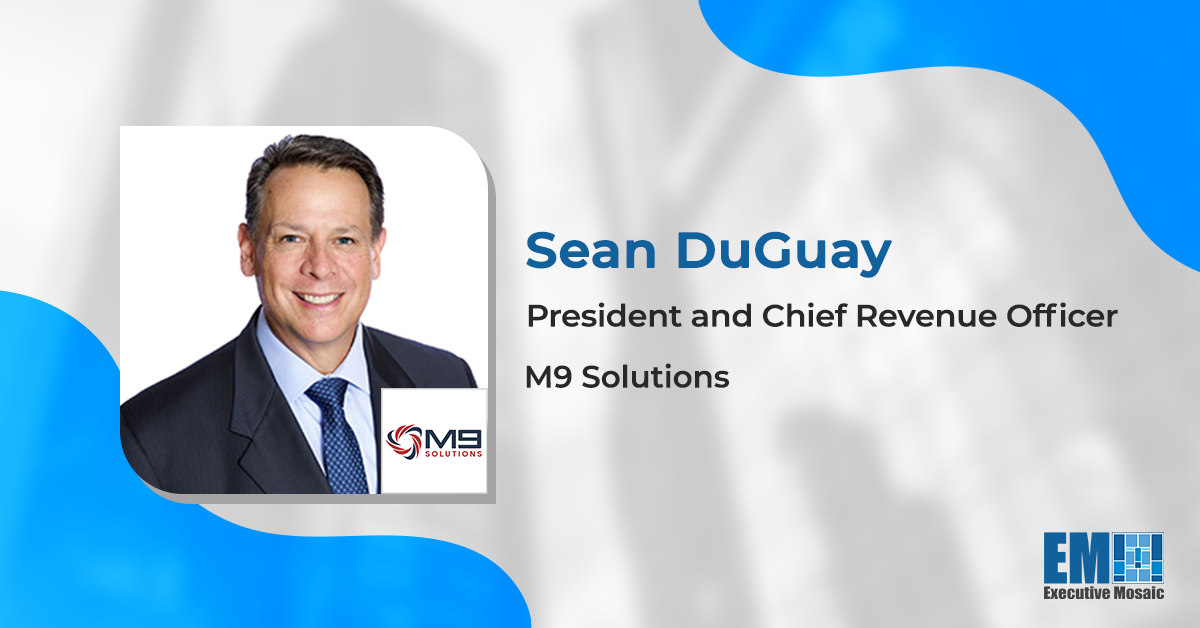As the digital world continues to expand, cybersecurity, data and new technologies are rising to the forefront and becoming essential to government and industry organizations alike. M9 Solutions President and Chief Revenue Officer Sean DuGuay sat down with Executive Mosaic to discuss how the defense landscape is changing, which emerging technologies are best poised to support evolving federal missions and why the biggest threat to the country’s cyber systems is a lack of talent.
DuGuay was appointed to his current role in April 2023 after spending three years as principal of national security and defense at Capgemini.
Read below for DuGuay’s full Executive Spotlight interview:
Where are you seeing opportunities for expansion in your company’s portfolio? What new capabilities or markets are you eyeing?
Versatility and diversification. I’m a fan of Warren Buffet. In his words, ‘Never depend on a single income. Make investments to create a second source.’ At M9 Solutions we have a wonderful foundation to include digital transformation, cloud migration, software development, data science and cybersecurity. These are all great areas to build from and as a true entrepreneur, I intend to surround myself with relentless workers, positive attitudes, people who ask questions and dreamers, as well as partner with those who have a foothold in the innovation economies of our country.
The Office of Management and Budget is consistent in sending out executive orders for federal agencies to ‘Improve the Nation’s Cybersecurity.’ Our aging supply chain, old technologies still in use and the recently released NIST Secure Software Development Framework clearly show we as a nation need to upgrade our cyber posture. What none of the OMB does is provide the agencies with ways to afford these mandated changes.
As an example, a recent legacy government program with which I am intimately familiar was given a security check. The result was more than a dozen POAMs (Plan of Action Milestones) issued which would cost the government another $4.5 million to fix. The program was bid at a fixed price prior to the POAMs being issued. Who pays for the fixes? Should it be the government contractor which was not made aware of the security issues? No. Should it be the taxpayer who knows the program was bid for and won by a competent contractor? No. The government needs to learn how to rationalize existing programs and strangle out applications which don’t have the same value they once did. This in turn will free up the dollars necessary to fix issues.
The next area is data. Structured, unstructured, at rest and in transit. How can our customers get the most out of their data? How can they be sure it’s secure and the actual data they requested versus something a nefarious actor messed with? Addressing all things data is where M9 Solutions will make a significant impact. Data is the lifeblood of everything we are discussing around regulation of AI, digital transformation, automation and security. We live and work at every level: government, commercial and personal in an ever-changing environment largely driven by the pace of innovation and technology, which is affecting underinvestment in many of the country’s infrastructure and industrial systems in both government and commercial. This means we not only need to be responsive to the environments in which we work and live, but also find ways to leapfrog the status quo so we can get ahead of the game and build for the future.
What do you think is the biggest threat facing U.S. cyber systems today, and what can be done to protect against that threat?
Honestly, the biggest threat facing the U.S. and cyber systems today is the lack of talent. We’re all pulling from the same talent pool. The same ‘qualified’ recruited candidate has five offers before they even think about leaving their current role and it’s getting worse. There is no shortage of articles from the industry rags discussing the issue. If you couple that with the recent reports of how COVID has devastated our youth in STEM and that those numbers are so far down in the global scale in testing, I worry about our future to be able to bring the right talent to the table and answer the ever-increasing adversary.
At M9 Solutions, we’re thinking outside the box. We’re bringing in those ‘untrained’ candidates and assessing those who have the aptitude with the motivation to learn a new skill and supplementing that with M9 subject matter experts. We have access to commercial training programs and even with our clients, we’ll put it in the contract that we’ll ensure they get that training in addition to bringing qualified talent to the contract.
Data is often coming from multiple sources that organizations need to collect, analyze and understand in order to use it. What are some of the key challenges and opportunities you’re seeing emerge as organizations harness data and use it to drive decisions?
The challenges are very well known and understood: data integration, data quality, data security/privacy, talent and skills gaps, as well as ethical considerations. The true opportunities lie in the following:
- Informed decision-making: By effectively analyzing and interpreting data, organizations can make data-driven decisions. Helping guide those organizations with the proper people, processes and technologies will make a huge difference.
- Personalization and customer experience: Data allows organizations to understand customer preference, personalize offerings and enhance the overall customer experience. Tailored recommendations, targeted marketing campaigns and improved customer service are but a few of the benefits.
- Innovation and new business models: Data can uncover new opportunities and drive innovation. Organizations can use data to identify emerging trends, develop new products and services and not to mention bring about a new way to do business.
- Predictive analytics: By analyzing historical data, organizations can build predictive models that forecast future outcomes. Predictive analytics enables proactive decision making, risk mitigation, demand forecasting and optimized resource allocation.
All of these are like the fingers in a glove and very interconnected. Any security gaps at any level will affect how the other levers can be used against us or help us to build a robust backbone. This extends to both hardware and software constructs and is enabled by embedded programming, automation controls and specific functionality. The global defense landscape is moving fast and we will need to look at points of failure across the systems.
What’s your outlook on the global defense landscape? What significant changes or trends are you seeing, and how are those factors moving the GovCon market?
For us to grow globally in the defense sector it is not enough to just be a provider of services, we need to be a creator of expertise and meet demand for the warfighter. There are numerous trends in the defense sector, but I’ll keep them to the three that M9 Solutions is focused on.
Artificial intelligence and machine learning technologies are being increasingly integrated into defense systems today. These technologies enhance autonomous capabilities, improve situational awareness and enable predictive analytics which support the decision-making process in areas like surveillance, cyber defense and logistics.
Cybersecurity is an ever-growing issue because with the growing reliance on digital systems and interconnected networks, cybersecurity has become a critical concern for defense organizations. The defense technology market is witnessing a rise in the demand for robust cybersecurity solutions to protect sensitive data, critical infrastructure and military communication systems from cyber threats.
Data analytics and big data remain prominent. The defense sector is increasingly leveraging data analytics and big data to extract insights from large volumes of information. This helps in intelligence gathering, threat assessment, mission planning, maintenance optimization and resource allocation, among other applications.
What emerging technologies do you anticipate will have the greatest impact on our standing in the great power competition in the next few years? Where are you seeing opportunities for accelerated, meaningful tech growth for the U.S.?
I’d like to provide a two-part answer for this question because the markets are slightly different in federal civilian (FedCiv) and defense.
For the defense sector as well as certain components of our homeland security, I would suggest that without a doubt, this is going to be a combination of AI/ML and sophisticated multi-domain operations. Modern defense operations involve multiple domains, including land, sea, air, space and cyberspace. The integration and coordination of capabilities across these domains are essential for effective defense strategies. Defense technology is evolving to enable seamless communication, interoperability and synchronized operations across multiple domains. How the AI/ML models are built, what data we use to train them and how/if they can be made to be self-learning will ultimately make us more competitive. Some areas are ripe for robotic process automation while others will still need experience and domain knowledge and will be human assisted AI/ML.
For FedCiv, although their AI/ML hasn’t yet taken off, I believe it will soon. FedCiv can benefit greatly from AI/ML in the automation of routine tasks and processes so that the current staff can refocus on service and timely response to the masses. The U.S. Customs and Border Patrol has accomplished this quite well recently.
Additionally, quantum technologies — including quantum computing, quantum communications and quantum sensing — have the potential to revolutionize various fields. Quantum computing can solve complex problems exponentially faster, which could significantly impact areas like cryptography, optimization and simulations.
Lastly, 5G and beyond. The rollout and adoption of 5G networks will have a transformative impact on connectivity, communication and data transmission. Faster speeds, lower latency and higher device density will enable new applications and services, such as the Internet of Things, autonomous vehicles and smart agencies. Nations that lead in 5G deployment and utilize its potential can stimulate growth, innovation and technological advancements.

